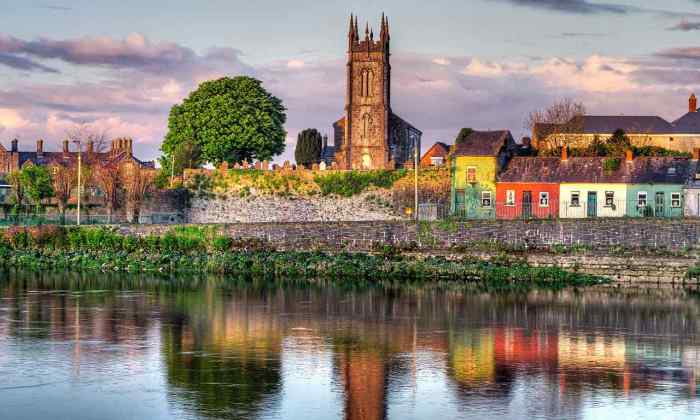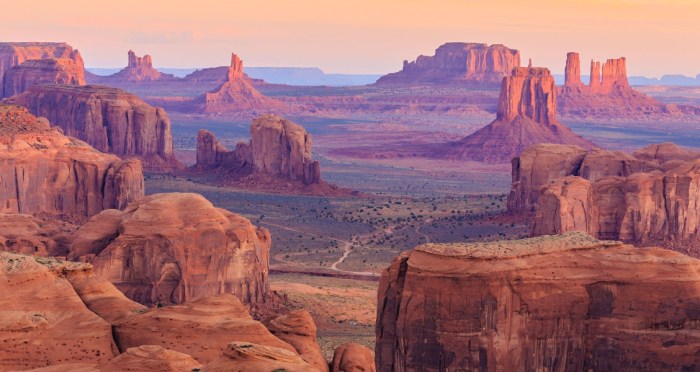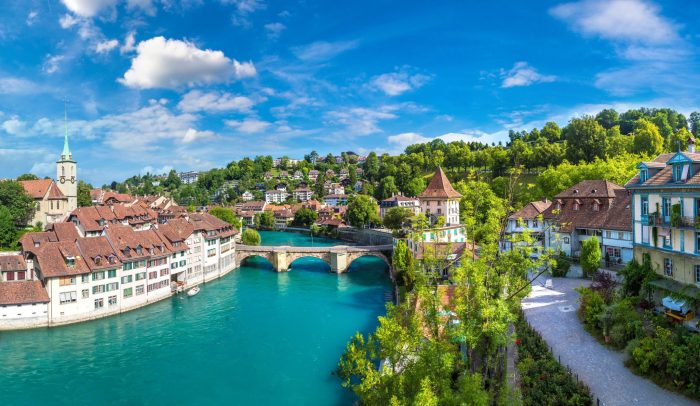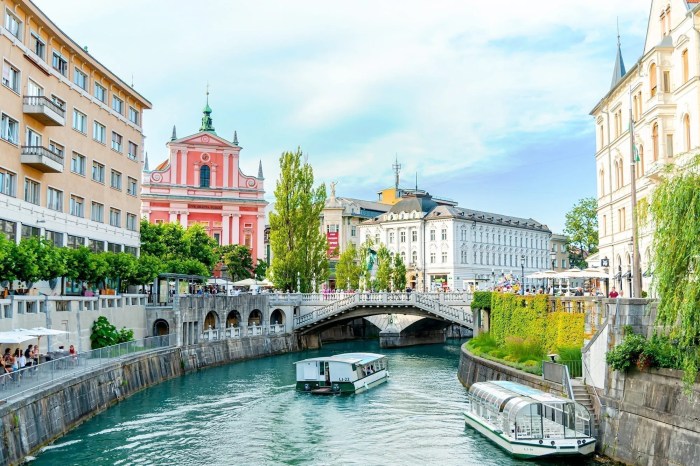Top 10 Places To Visit In Ireland
Top 10 Places to Visit In Ireland: From the vibrant capital city of Dublin to the rugged beauty of Connemara, the Emerald Isle offers a captivating blend of history, culture, and natural wonders. Whether you’re seeking a lively city break, a scenic coastal drive, or a hike through breathtaking landscapes, Ireland has something for everyone.
This guide will take you on a journey through the top 10 must-see destinations in Ireland, showcasing the best of what this enchanting country has to offer. Get ready to explore ancient castles, charming villages, and awe-inspiring natural wonders that will leave you breathless.
Dublin: The Vibrant Capital
Dublin, the capital of Ireland, is a city steeped in history, culture, and charm. With its cobblestone streets, historic landmarks, and vibrant nightlife, Dublin offers something for everyone.
Historical Significance
Dublin’s history dates back to the Viking Age, and the city has played a pivotal role in Irish history. In the 11th century, Dublin was established as a Viking settlement and later became the seat of the Norman kings of Ireland.
The city’s rich history is evident in its many historic buildings, including Dublin Castle, Trinity College, and Christ Church Cathedral.
Must-Visit Attractions
Dublin is home to a wealth of attractions that showcase its rich history and culture. Here are some of the must-visit attractions:
- Trinity College:Founded in 1592, Trinity College is Ireland’s oldest university and one of the most prestigious universities in the world. Visitors can tour the historic campus, including the iconic Book of Kells, a beautifully illuminated manuscript that dates back to the 9th century.
- Guinness Storehouse:The Guinness Storehouse is a must-visit for any beer lover. Visitors can learn about the history of Guinness, take a tour of the brewery, and enjoy a pint of the famous stout at the Gravity Bar, which offers panoramic views of Dublin.
- Dublin Castle:Dublin Castle is a historic building that has served as the seat of power in Ireland for centuries. Visitors can tour the State Apartments, explore the historic Chapel Royal, and learn about the castle’s fascinating history.
- Christ Church Cathedral:Christ Church Cathedral is one of the oldest buildings in Dublin, dating back to the 11th century. Visitors can explore the cathedral’s impressive architecture, including its intricate carvings and stained glass windows.
- Kilmainham Gaol:Kilmainham Gaol is a former prison that played a significant role in Irish history. Visitors can take a tour of the prison and learn about its history, including the stories of the prisoners who were held there.
Suggested 2-Day Itinerary
Here’s a suggested itinerary for a 2-day trip to Dublin:
Day 1
- Start your day with a visit to Trinity College, where you can explore the campus and see the Book of Kells.
- In the afternoon, head to the Guinness Storehouse for a tour of the brewery and a pint of Guinness at the Gravity Bar.
- In the evening, enjoy a traditional Irish dinner and a pint of Guinness at one of Dublin’s many pubs.
Day 2
- Start your day with a visit to Dublin Castle, where you can tour the State Apartments and explore the historic Chapel Royal.
- In the afternoon, head to Christ Church Cathedral to admire its impressive architecture.
- In the evening, enjoy a performance at the Abbey Theatre, one of Dublin’s most famous theaters.
The Wild Atlantic Way
The Wild Atlantic Way is a 2,500 kilometer (1,553 miles) scenic driving route that hugs the rugged west coast of Ireland. It’s known for its dramatic cliffs, pristine beaches, charming towns, and rich history. The route is a must-do for any visitor to Ireland, offering a unique glimpse into the country’s raw beauty and captivating culture.
Popular Stops Along the Wild Atlantic Way
The Wild Atlantic Way is packed with incredible stops along the way, each offering a unique experience. Some of the most popular destinations include:
- Cliffs of Moher:These dramatic cliffs rise 214 meters (702 feet) above the Atlantic Ocean, offering breathtaking views of the surrounding coastline. Visitors can explore the cliffs on foot, take a boat tour, or simply enjoy the awe-inspiring scenery.
- Galway City:This vibrant city is known for its lively pubs, traditional music scene, and friendly atmosphere. It’s also a great base for exploring the surrounding Connemara region.
- Dingle Peninsula:This scenic peninsula is home to stunning beaches, rugged mountains, and the famous Dingle Bay. Visitors can enjoy whale watching, hiking, and exploring the charming villages along the way.
- Slea Head Drive:This winding coastal road offers stunning views of the Atlantic Ocean, the Blasket Islands, and the dramatic landscape of the Dingle Peninsula. It’s a must-do for any visitor to the region.
- Connemara National Park:This vast park offers stunning views of mountains, lakes, and bogs. Visitors can enjoy hiking, fishing, and exploring the unique flora and fauna of the region.
Top 5 Must-See Locations on the Wild Atlantic Way
| Rank | Location | Description |
|---|---|---|
| 1 | Cliffs of Moher | Dramatic cliffs rising 214 meters (702 feet) above the Atlantic Ocean, offering breathtaking views of the surrounding coastline. |
| 2 | Galway City | Vibrant city known for its lively pubs, traditional music scene, and friendly atmosphere. |
| 3 | Dingle Peninsula | Scenic peninsula home to stunning beaches, rugged mountains, and the famous Dingle Bay. |
| 4 | Slea Head Drive | Winding coastal road offering stunning views of the Atlantic Ocean, the Blasket Islands, and the dramatic landscape of the Dingle Peninsula. |
| 5 | Connemara National Park | Vast park offering stunning views of mountains, lakes, and bogs. |
The Ring of Kerry
The Ring of Kerry is a scenic drive that circles the Iveragh Peninsula in County Kerry, Ireland. It’s one of the most popular tourist routes in the country, offering breathtaking views of mountains, lakes, and the Atlantic Ocean.
Scenic Drive and Captivating Views
The Ring of Kerry is a 111-mile (179 km) circular route that takes you through some of the most stunning landscapes in Ireland. You’ll see towering mountains like Carrauntoohil, the highest peak in Ireland, and the Macgillycuddy’s Reeks mountain range.
You’ll also drive along the rugged coastline, where you can see dramatic cliffs, secluded beaches, and charming villages. There are many opportunities to stop along the way and take in the views. You can hike, bike, or simply relax and enjoy the scenery.
Charming Villages and Natural Wonders
The Ring of Kerry is home to a number of charming villages, each with its own unique character. Here are a few of the most popular villages:
- Killarney: The largest town on the Ring of Kerry, Killarney is a great place to start your journey. It’s home to Killarney National Park, which offers hiking trails, boat tours, and stunning views of the Macgillycuddy’s Reeks. You can also visit Muckross House, a 19th-century mansion with beautiful gardens.
- Sneem: Sneem is a picturesque village with a charming harbor and colorful houses. It’s a great place to stop for lunch or to enjoy a pint in a traditional Irish pub.
- Waterville: Waterville is a coastal village known for its beautiful beaches and its connection to the famous golfer, Charlie Chaplin. You can visit Waterville Golf Links, which offers stunning views of the Atlantic Ocean. You can also explore the Charlie Chaplin Museum, which celebrates the life and work of the legendary actor.
- Cahersiveen: Cahersiveen is a historic town with a rich cultural heritage. It’s home to the Skellig Michael Visitor Centre, which provides information about the UNESCO World Heritage Site, Skellig Michael. You can also visit the Valentia Island, which is connected to the mainland by a bridge.
So, you’re thinking about visiting Ireland? It’s a beautiful country with tons of history and stunning scenery. But if you’re looking for something a bit different, maybe you should check out Top 10 Places To Visit in Brazil. Brazil has amazing beaches, rainforests, and vibrant cities.
Of course, if you’re into the whole Celtic vibe, then Ireland is totally your jam. You can’t go wrong either way!
The island is known for its stunning scenery and its history.
Activities and Experiences
There are many activities and experiences available along the Ring of Kerry. Here are a few ideas:
- Hiking: The Ring of Kerry is a great place to go hiking. There are trails for all levels of experience, from easy walks to challenging climbs. Some popular hiking trails include the Kerry Way, the Dingle Way, and the Macgillycuddy’s Reeks.
- Cycling: The Ring of Kerry is also a popular cycling destination. You can rent a bike in Killarney or other towns along the route. There are many scenic routes to choose from, including the Gap of Dunloe and the Ladies View.
- Boat Tours: There are a number of boat tours available on the Ring of Kerry. You can take a cruise on Lough Lein in Killarney, or you can go on a wildlife tour to see seals, dolphins, and other marine life.
You can also take a ferry to the Skellig Islands, which are home to ancient monastic settlements.
- Fishing: The Ring of Kerry is a great place to go fishing. You can fish for salmon, trout, and other species. There are many fishing spots available, both on the coast and in the lakes and rivers.
Giant’s Causeway
The Giant’s Causeway is a breathtaking natural wonder located on the northern coast of County Antrim, Northern Ireland. This UNESCO World Heritage Site is renowned for its unique geological formation of approximately 40,000 interlocking basalt columns, a testament to the power of volcanic activity.
Geological Formation
The Giant’s Causeway was formed millions of years ago during a period of intense volcanic activity. Molten lava erupted from fissures in the earth’s crust, flowing out over the surrounding landscape. As the lava cooled and solidified, it contracted, creating a network of cracks that extended vertically through the rock.
These cracks, known as columnar joints, are responsible for the distinctive hexagonal shape of the basalt columns. The process of columnar jointing is a natural phenomenon that occurs when lava cools and contracts, creating a network of cracks that extend vertically through the rock.
UNESCO World Heritage Site
The Giant’s Causeway was designated a UNESCO World Heritage Site in 1986, recognizing its outstanding universal value as a geological formation and its significance in understanding the Earth’s history. The site encompasses a variety of geological features, including the iconic Causeway itself, the dramatic cliffs of the Antrim Coast, and the surrounding landscape.
Comparison with Other Geological Wonders in Ireland, Top 10 Places to Visit In Ireland
The Giant’s Causeway is a geological wonder, but it’s not the only one in Ireland. Here’s a comparison with other notable geological formations in the country:
| Geological Wonder | Location | Formation | Significance |
|---|---|---|---|
| Giant’s Causeway | County Antrim, Northern Ireland | Volcanic activity, columnar jointing | UNESCO World Heritage Site, unique basalt columns |
| Cliffs of Moher | County Clare, Ireland | Erosion of limestone cliffs by the Atlantic Ocean | Dramatic cliffs, popular tourist destination |
| Carlingford Lough | County Louth and County Down, Ireland | Glacial erosion and deposition | Scenic fjord, home to diverse wildlife |
Galway City
Galway City, nestled on Ireland’s west coast, is a vibrant hub of culture and history. Known for its lively atmosphere, friendly locals, and stunning natural surroundings, Galway is a must-visit destination for anyone exploring Ireland.
Cultural Heritage
Galway’s rich history is evident throughout the city. The city’s medieval walls, built in the 13th century, still stand today, a testament to Galway’s past as a thriving trading center. The city also boasts a number of historical landmarks, including the Spanish Arch, a 16th-century gateway to the harbor, and Lynch’s Castle, a 15th-century building that now houses a bank.
Arts and Culture
Galway is renowned for its thriving arts scene. The city hosts a number of festivals throughout the year, including the Galway International Arts Festival, the Galway Film Fleadh, and the Galway Theatre Festival. These festivals bring together artists, performers, and audiences from around the world, creating a vibrant and exciting atmosphere.
Galway is also home to a number of theaters, art galleries, and music venues. The city’s streets are filled with street performers, musicians, and artists, adding to the city’s vibrant and eclectic atmosphere.
Traditional Music
Galway is a haven for traditional Irish music. The city is home to a number of pubs that feature live music nightly, playing traditional Irish jigs, reels, and ballads. The pubs are often packed with locals and tourists alike, creating a lively and festive atmosphere.
Popular Pubs and Restaurants
Galway is home to a number of popular pubs and restaurants. Here are a few of the most notable:
- Tigh Neachtain: This traditional Irish pub is known for its live music and friendly atmosphere. It’s a great place to enjoy a pint of Guinness and soak up the local culture.
- The Quays: Located on the waterfront, The Quays offers stunning views of Galway Bay. The pub is known for its seafood dishes and its lively atmosphere.
- O’Connell’s: This historic pub has been a Galway institution for over a century. It’s a great place to enjoy a pint of Guinness and listen to traditional Irish music.
- The King’s Head: This popular pub is known for its wide selection of craft beers and its friendly atmosphere.
- Ard Bia: This restaurant is known for its delicious and innovative vegetarian and vegan dishes.
- The Salt House: This restaurant is known for its fresh seafood dishes and its stunning waterfront location.
- The Brasserie on the Corner: This restaurant is known for its classic French cuisine and its elegant atmosphere.
Connemara: Rugged Beauty
Connemara, a region in County Galway, Ireland, is renowned for its captivating rugged beauty and breathtaking natural wonders. This area is a haven for nature enthusiasts and those seeking an escape from the hustle and bustle of city life.
Natural Wonders of Connemara
The landscape of Connemara is a tapestry of mountains, lakes, and coastal landscapes that will leave you in awe.
From the Cliffs of Moher to the Giant’s Causeway, Ireland has some pretty epic landscapes. But if you’re looking for a more laid-back vibe with a side of Greek island charm, you might want to check out Top 10 Places To Visit in Milos.
Milos is known for its volcanic beaches, hidden coves, and delicious seafood, and it’s a great place to escape the crowds and soak up the sun. Of course, you can’t forget about the pubs and the craic in Ireland – there’s no place like it!
- Mountains:The Twelve Bens, a range of mountains in the heart of Connemara, are a sight to behold. These peaks, reaching heights of over 2,000 feet, offer stunning views of the surrounding countryside.
- Lakes:Connemara is dotted with numerous lakes, each with its own unique charm. Lough Corrib, the largest lake in Ireland, is a popular spot for fishing and watersports.
- Coastal Landscapes:The rugged coastline of Connemara is a photographer’s dream. The dramatic cliffs, sandy beaches, and rocky inlets create a mesmerizing vista.
Outdoor Activities in Connemara
Connemara offers a plethora of outdoor activities for all fitness levels and interests.
- Hiking:With its diverse terrain, Connemara is a hiker’s paradise. From gentle strolls along coastal paths to challenging ascents of the Twelve Bens, there’s a trail for everyone.
- Kayaking:The tranquil lakes and sheltered bays of Connemara provide the perfect setting for a kayaking adventure. Explore the hidden coves and inlets, or simply enjoy the serenity of paddling across the water.
- Cycling:Connemara’s scenic roads and paths are ideal for cycling. Whether you’re a seasoned cyclist or a casual rider, you’ll be rewarded with breathtaking views.
Killarney National Park: Nature’s Paradise: Top 10 Places To Visit In Ireland
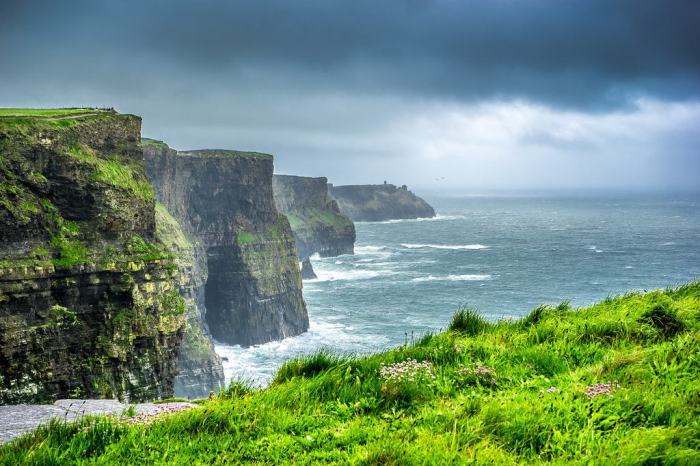
Killarney National Park, nestled in the southwest of Ireland, is a haven for nature enthusiasts and a testament to the country’s rich biodiversity. It’s a place where ancient forests meet towering mountains, where crystal-clear lakes reflect the vibrant hues of the sky, and where a symphony of bird songs fills the air.
Ecological Significance
Killarney National Park is a vital ecological treasure, harboring a remarkable array of plant and animal life. It’s home to a diverse range of habitats, including oakwoods, bogland, and alpine meadows, each supporting a unique ecosystem. The park’s unique geographical location and diverse microclimates contribute to its remarkable biodiversity.
Natural Wonders
The park boasts three stunning lakes: Lough Lein, Muckross Lake, and Upper Lake. These lakes are interconnected and offer breathtaking views of the surrounding mountains and forests. The park’s landscape is dominated by the Macgillycuddy’s Reeks, Ireland’s highest mountain range, with Carrauntoohil, the highest peak, reaching an elevation of 3,407 feet.
The park’s forests are a captivating blend of native and introduced species, with oak, ash, and yew trees creating a dense canopy that provides shelter to a wide range of wildlife.
From the rolling green hills of County Kerry to the bustling streets of Dublin, Ireland has tons of awesome places to check out. And if you’re looking for even more travel inspo, you can check out the Top 10 Places To Visit in Europe for some serious wanderlust.
But let’s be real, Ireland is a must-see for anyone who wants to experience a unique and vibrant culture. So grab your passport and get ready to explore the Emerald Isle!
Popular Trails and Viewpoints
The park offers a network of trails that cater to all levels of fitness, from leisurely strolls to challenging hikes.
- The Old Kenmare Road:A scenic trail that follows the route of an ancient road, offering panoramic views of the surrounding mountains and lakes.
- The Muckross Abbey Loop:A circular trail that takes you past Muckross Abbey, a 15th-century Franciscan friary, and through the picturesque Muckross Gardens.
- The Torc Waterfall Walk:A short but rewarding walk that leads to the cascading Torc Waterfall, a popular spot for photography.
Some of the park’s most popular viewpoints include:
- Lady’s View:A stunning viewpoint that offers panoramic views of Lough Lein and the surrounding mountains.
- Torc Mountain:A challenging hike that rewards you with breathtaking views of the park and the surrounding countryside.
- Muckross House:The historic Muckross House, located on the shores of Muckross Lake, offers panoramic views of the surrounding landscape.
Dingle Peninsula: Scenic Escape
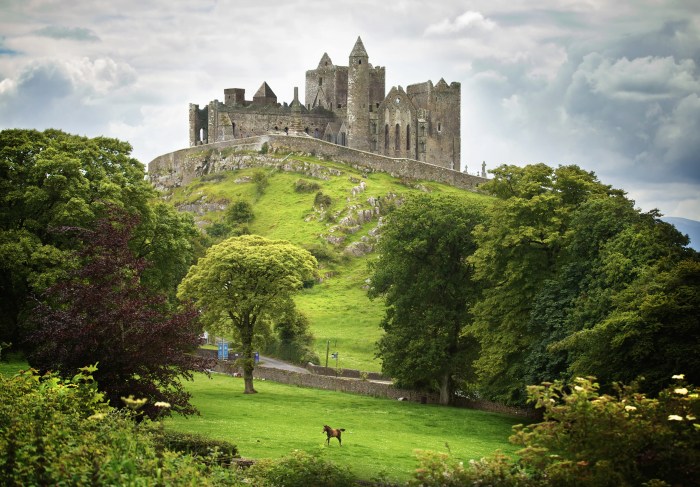
The Dingle Peninsula, a rugged and breathtaking stretch of land jutting out into the Atlantic Ocean, is a must-visit for anyone seeking a scenic escape in Ireland. This peninsula boasts stunning coastline, charming villages, and a rich cultural heritage.
The Dingle Peninsula’s Coastal Beauty
The Dingle Peninsula’s coastline is a sight to behold. Its dramatic cliffs, sandy beaches, and crystal-clear waters offer breathtaking views and endless opportunities for outdoor adventure.
- Slea Head Drive: This scenic drive offers panoramic views of the Atlantic Ocean, the Blasket Islands, and the dramatic cliffs of the peninsula. The drive is dotted with charming villages and historic sites, making it a perfect way to experience the peninsula’s beauty.
- Coumeenoole Beach: This secluded beach is known for its white sand and clear waters. It’s a perfect spot for swimming, sunbathing, or simply enjoying the peace and quiet of the natural surroundings.
- The Blasket Islands: These rugged islands, located off the coast of the peninsula, are a popular destination for boat trips. Visitors can explore the islands’ history, culture, and natural beauty.
History and Culture
The Dingle Peninsula has a rich history and culture. It’s home to numerous archaeological sites, including ancient forts, stone circles, and early Christian churches.
- Gallarus Oratory: This early Christian church, dating back to the 6th century, is a fascinating example of early Irish architecture.
- The Dingle Distillery: This distillery produces award-winning Irish whiskey and offers tours and tastings. Visitors can learn about the history of whiskey making in Ireland and sample the local product.
- The Dingle Peninsula’s Traditional Irish Language: The Dingle Peninsula is one of the few remaining areas in Ireland where the Irish language is still spoken by a significant portion of the population. Visitors can learn about the language and its cultural significance by visiting the Dingle Irish Language College or by taking a guided tour.
Exploring the Dingle Peninsula
There are many ways to explore the Dingle Peninsula.
- Boat Trips: Boat trips are a great way to see the peninsula’s coastline and the Blasket Islands from a different perspective. Many tour operators offer trips that include wildlife watching, fishing, and visits to historical sites.
- Hiking and Walking: The Dingle Peninsula offers a variety of hiking trails for all levels of fitness. From short walks to challenging hikes, there’s something for everyone.
- Cycling: The Dingle Peninsula is a popular destination for cycling. The peninsula’s scenic roads and quiet lanes offer a unique way to explore the area.
Wicklow Mountains National Park
Escape the hustle and bustle of city life and immerse yourself in the breathtaking beauty of Wicklow Mountains National Park, Ireland’s largest national park. This rugged landscape is a haven for outdoor enthusiasts, boasting a tapestry of rolling hills, verdant valleys, cascading waterfalls, and sparkling lakes.
The park is a hiker’s paradise, with a network of trails catering to all levels of experience.
Hiking Opportunities
Wicklow Mountains National Park offers a wide array of hiking opportunities, from leisurely strolls to challenging climbs. The park is home to some of Ireland’s most iconic trails, including the Wicklow Way, a 132 km (82 mi) long-distance trail that traverses the heart of the park.
The Wicklow Way offers stunning views of the surrounding countryside, and hikers can choose from a variety of shorter sections to suit their fitness level and time constraints.
Waterfalls and Lakes
The park is adorned with numerous waterfalls, each with its own unique charm. Powerscourt Waterfall, one of Ireland’s tallest waterfalls, plunges dramatically over a cliff face, creating a mesmerizing spectacle. The park is also home to several picturesque lakes, including Lough Tay, known for its distinctive blue waters.
Recommended Hikes and Viewpoints
The park offers a variety of scenic hikes and viewpoints that provide panoramic views of the surrounding landscape. Here are some of the most popular options:
- The Wicklow Way:This long-distance trail offers stunning views of the surrounding countryside. Hikers can choose from a variety of shorter sections to suit their fitness level and time constraints.
- Glendalough Valley:This picturesque valley is home to a variety of hiking trails, including the Upper Lake Loop, which offers stunning views of the surrounding mountains.
- Mullaghcleevaun:This mountain is the highest peak in the Wicklow Mountains, and offers panoramic views of the surrounding countryside. The climb to the summit is challenging, but the views are well worth the effort.
- Powerscourt Estate:This historic estate offers a variety of hiking trails, including the Powerscourt Waterfall Walk, which leads to the base of Ireland’s tallest waterfall.
- Lugnaquilla:This mountain is the second highest peak in the Wicklow Mountains, and offers panoramic views of the surrounding countryside. The climb to the summit is challenging, but the views are well worth the effort.
Northern Ireland: A Different Landscape
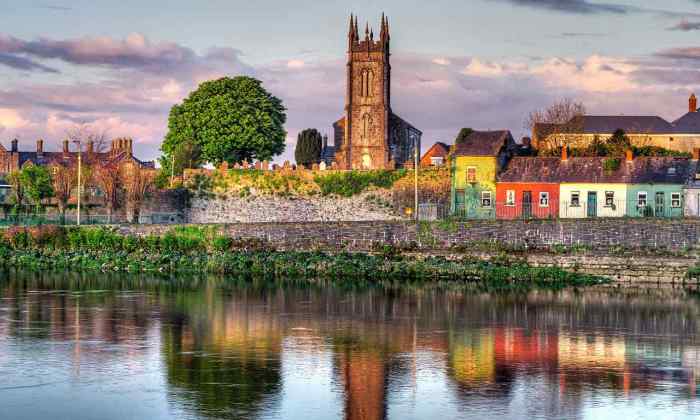
While the Republic of Ireland is known for its lush green landscapes, Northern Ireland offers a distinct and captivating experience. From the dramatic cliffs of the Causeway Coast to the bustling streets of Belfast, Northern Ireland presents a unique blend of rugged beauty and vibrant culture.
The Giant’s Causeway
The Giant’s Causeway, a UNESCO World Heritage Site, is one of Northern Ireland’s most iconic attractions. This geological marvel features thousands of interlocking basalt columns that stretch out into the North Atlantic Ocean. The columns were formed millions of years ago by volcanic activity, and their unique hexagonal shapes and intricate patterns are a testament to nature’s power.
Belfast City
Belfast, the capital of Northern Ireland, is a vibrant city with a rich history and a thriving cultural scene. Visitors can explore the Titanic Belfast, a museum dedicated to the ill-fated ship that was built in the city. Other notable attractions include the Belfast City Hall, the Ulster Museum, and the vibrant Queen’s Quarter.
The Causeway Coastal Route
The Causeway Coastal Route is a scenic driving route that winds its way along the dramatic coastline of Northern Ireland. The route encompasses some of the region’s most breathtaking landscapes, including the Giant’s Causeway, the Carrick-a-Rede Rope Bridge, and the picturesque villages of Portstewart and Ballycastle.
The route is a popular destination for road trips, offering stunning views and a chance to experience the natural beauty of Northern Ireland.
Top 5 Must-See Locations in Northern Ireland
| Rank | Location | Description |
|---|---|---|
| 1 | Giant’s Causeway | A UNESCO World Heritage Site featuring thousands of interlocking basalt columns. |
| 2 | Belfast City | The vibrant capital of Northern Ireland, with attractions like the Titanic Belfast and Belfast City Hall. |
| 3 | Causeway Coastal Route | A scenic driving route showcasing the dramatic coastline and iconic landmarks. |
| 4 | Carrick-a-Rede Rope Bridge | A historic rope bridge spanning a narrow chasm, offering breathtaking views. |
| 5 | The Mourne Mountains | A stunning mountain range with dramatic peaks and scenic trails. |
Concluding Remarks
From the bustling streets of Dublin to the tranquil shores of the Wild Atlantic Way, Ireland offers an unforgettable travel experience. Whether you’re exploring historic sites, indulging in local cuisine, or simply soaking in the breathtaking scenery, you’re sure to create memories that will last a lifetime.
So, pack your bags, grab your map, and get ready to embark on an adventure through the Emerald Isle. You won’t regret it!
FAQ Explained
What is the best time to visit Ireland?
The best time to visit Ireland depends on your preferences. Spring (April-May) and fall (September-October) offer mild weather and fewer crowds. Summer (June-August) is the most popular time to visit, with longer days and warm temperatures, but expect higher prices and more tourists.
Do I need a visa to visit Ireland?
Visa requirements vary depending on your nationality. Citizens of many countries can enter Ireland for up to 90 days without a visa. Check with the Irish Embassy or Consulate in your country for specific visa requirements.
What is the currency used in Ireland?
The currency used in Ireland is the Euro (€). You can exchange currency at banks, airports, and exchange bureaus. Credit cards are widely accepted in Ireland.
